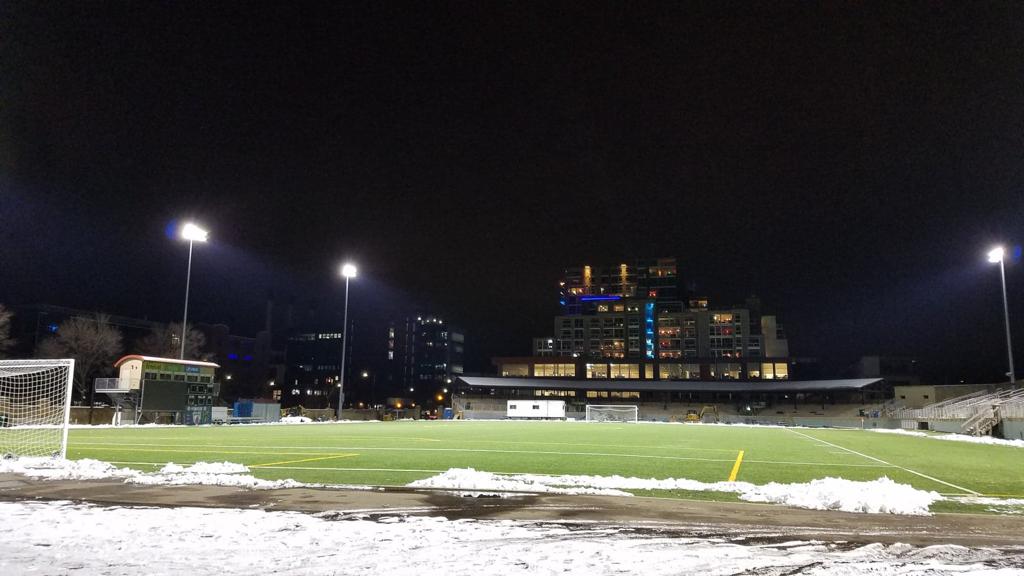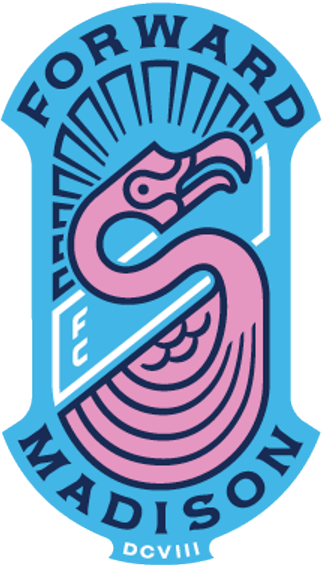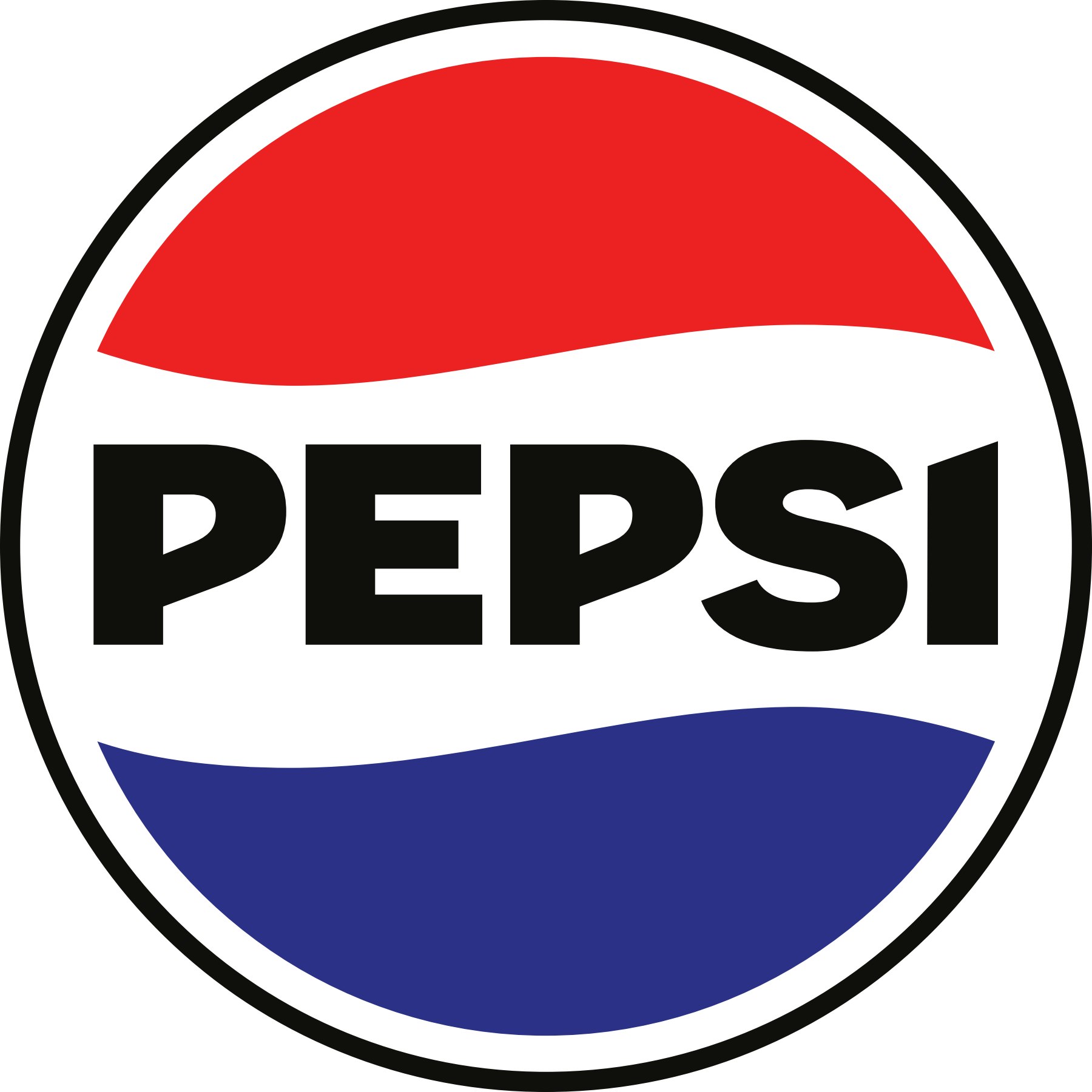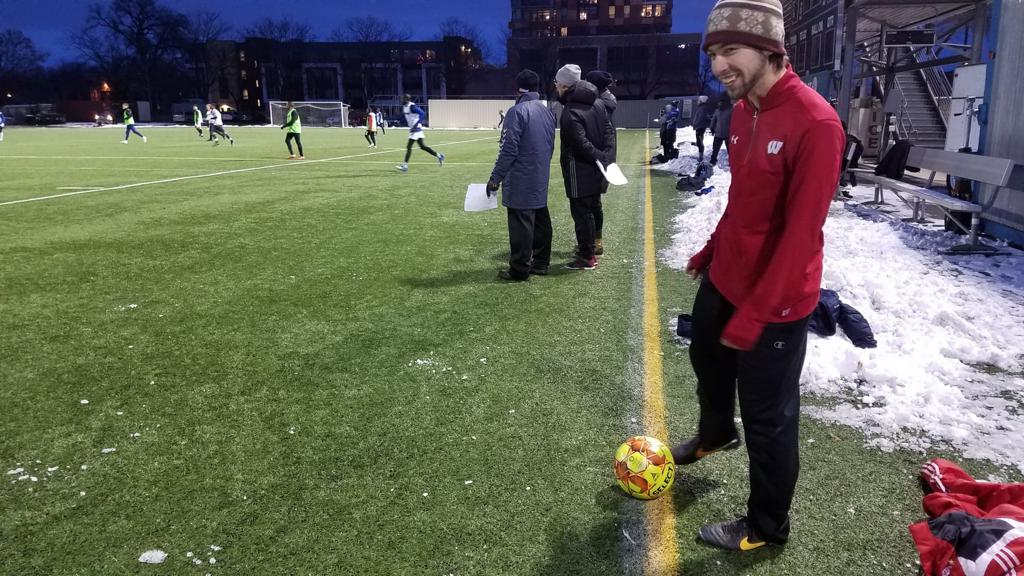
As the sun goes down, I can feel it in my fingers. It’s putting pressure on my cheeks, now seeping through my cleats and into my toes. Everyone I talk to is feeling it, too.
“How’s it going out there?” I ask a trialist wearing an FC Barcelona ski cap.
“Cold.”
I go into the press box to try and warm up a bit.
“How are you feeling, Peter?” I ask.
“Cold.”
Now back down on the field. I see a goalkeeper taking practice saves, but he notices me first.
“It’s freezing,” he says. “You need more of a jacket.”
No kidding. It’s a 30-degree November night and there are still piles of snow swept up past the sidelines. Around me, a hundred athletes wearing neon training tops knock a flurry of yellow soccer balls through the air to each other, filling the void that millions of little snowflakes had rushed through that morning. These maybe aren’t the ideal conditions for soccer, but in Wisconsin this is just how it is. As the year wanes, the chill becomes palpable, permeating every aspect of daily life. And here at Breese Stevens Field in Madison, the cold is welcoming soccer to its annual guest list.
On Tuesday, Forward Madison FC announced the signings of Brian Bement and Eric Leonard, both of whom received contract offers following impressive performances in the team’s November tryouts. I was there, too, although I didn’t make it past day one, let alone get offered a roster spot. Instead, I went to test out my skills, take some notes and see what it’s really like to try out for a professional soccer club. I’m not sure what I was thinking, but I decided that I was going to try to be a professional soccer player.
As the sun goes down, I can feel it in my fingers. It’s putting pressure on my cheeks, now seeping through my cleats and into my toes. Everyone I talk to is feeling it, too.
“How’s it going out there?” I ask a trialist wearing an FC Barcelona ski cap.
“Cold.”
I go into the press box to try and warm up a bit.
“How are you feeling, Peter?” I ask.
“Cold.”
Now back down on the field. I see a goalkeeper taking practice saves, but he notices me first.
“It’s freezing,” he says. “You need more of a jacket.”
No kidding. It’s a 30-degree November night and there are still piles of snow swept up past the sidelines. Around me, a hundred athletes wearing neon training tops knock a flurry of yellow soccer balls through the air to each other, filling the void that millions of little snowflakes had rushed through that morning. These maybe aren’t the ideal conditions for soccer, but in Wisconsin this is just how it is. As the year wanes, the chill becomes palpable, permeating every aspect of daily life. And here at Breese Stevens Field in Madison, the cold is welcoming soccer to its annual guest list.
On Tuesday, Forward Madison FC announced the signings of Brian Bement and Eric Leonard, both of whom received contract offers following impressive performances in the team’s November tryouts. I was there, too, although I didn’t make it past day one, let alone get offered a roster spot. Instead, I went to test out my skills, take some notes and see what it’s really like to try out for a professional soccer club. I’m not sure what I was thinking, but I decided that I was going to try to be a professional soccer player.
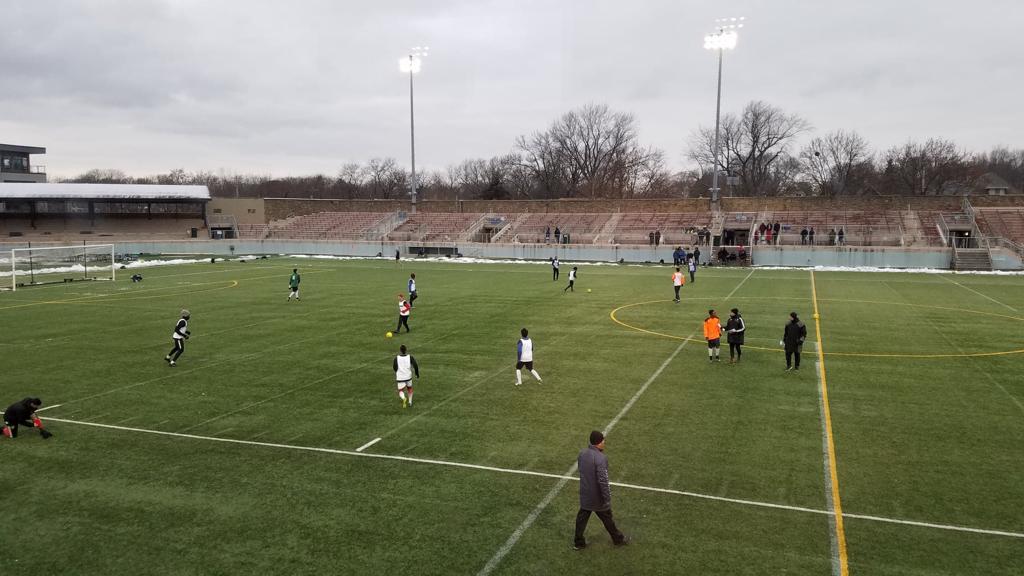
My name is Jason, and I’m 22 years old, which means I’m now too old for me to consider signing myself on Football Manager. I’ve also never played a competitive match of soccer in my life. I didn’t even play for my high school. In fact, my entire soccer repertoire consists of intramural league appearances with my friends and kicking the ball around alone for hours in my parents’ driveway when I was growing up.
I’m not exactly in terrible shape, but I’m probably not ready to be a professional athlete. I go for a run maybe once a week and I use my bicycle to get pretty much everywhere, but I also have a soft spot for ice cream and a propensity to spend my free time in front of a computer.
In order to go the tryouts prepared, I probably should have done some physical training. I could have gone to the gym, got on a regular exercise routine, or practiced my shooting technique. But in the end, I thought that would be too much work. Left with a limited number of options, I took a shortcut. I talked to an expert.
Nathan Sprenkel knows how to make a team through tryouts better than just about anyone. The former goalkeeper made the roster for three professional soccer teams through tryouts, including that of Indy Eleven, Forward Madison Managing Director Peter Wilt’s former club. When I told Sprenkel about my plan, perhaps he saw through me, but he was gracious enough to give me a few tips all the same.
The first thing Sprenkel told me was that I shouldn’t expect a cakewalk. Teams typically only take a handful of players, if that, from hundreds of hopefuls that come to try out. In the case of Forward Madison, that meant that of the 110 players who came to the club’s open tryout (not including myself), only four would eventually be picked to move on to the invitation tryout the next day.
“It’s tough because everyone there you don’t know, you’re trying to stand out from the group, it’s guys from really all over the world,” Sprenkel said. “You know they’re not going to form a team off of trialists, you know it’s a couple guys that are going to be getting contracts – if that.”
Okay, got it. So I’m going to have to make myself stick out. But how do I do that? Again, Sprenkel had the answer.
“Have some confidence and belief in yourself,” he told me. “Relax and enjoy the moment, because if you’re good enough, the talent will show.”
Well, to be perfectly honest, I wasn’t quite sure I was good enough. I hadn’t kicked a ball in weeks, and my last rec game had resulted in me giving away a penalty after touching the ball with my hand. But you know what? Trying out for a pro soccer team isn’t something you get to do all that often, so why not just give it a go anyway? I was nearly ready.
Before heading out, I only needed to talk to one more person. The manager.
Daryl Shore has been evaluating tryouts for 20 years, and as the new head coach of Forward Madison FC, he knew exactly how to go about this one. When I walked into his office, I started off by asking him some simple questions about how he was planning to approach the whole thing. I didn’t want to let him in on my true intentions quite yet, afraid that he might laugh me off – or worse, that he might take me seriously.
“We owe it to these players to give them their chance,” he told me, probably not realizing that he was talking to perhaps the least meritorious aspiring soccer player he’d ever laid eyes on. “The message to everybody is to come and and be ready to compete, but also to be ready to have fun.”
After a while, I worked up the nerve to shift the conversation to me. I asked Coach Shore what advice he would give to a prospective player.
“We’re giving all of these players an opportunity to showcase their talents,” he said. “I would tell you, one, don’t try to overdo it. Don’t try to over-impress.”
Don’t over-impress. Okay, well, at least I know I’ve got that part down.
My name is Jason, and I’m 22 years old, which means I’m now too old for me to consider signing myself on Football Manager. I’ve also never played a competitive match of soccer in my life. I didn’t even play for my high school. In fact, my entire soccer repertoire consists of intramural league appearances with my friends and kicking the ball around alone for hours in my parents’ driveway when I was growing up.
I’m not exactly in terrible shape, but I’m probably not ready to be a professional athlete. I go for a run maybe once a week and I use my bicycle to get pretty much everywhere, but I also have a soft spot for ice cream and a propensity to spend my free time in front of a computer.
In order to go the tryouts prepared, I probably should have done some physical training. I could have gone to the gym, got on a regular exercise routine, or practiced my shooting technique. But in the end, I thought that would be too much work. Left with a limited number of options, I took a shortcut. I talked to an expert.
Nathan Sprenkel knows how to make a team through tryouts better than just about anyone. The former goalkeeper made the roster for three professional soccer teams through tryouts, including that of Indy Eleven, Forward Madison Managing Director Peter Wilt’s former club. When I told Sprenkel about my plan, perhaps he saw through me, but he was gracious enough to give me a few tips all the same.
The first thing Sprenkel told me was that I shouldn’t expect a cakewalk. Teams typically only take a handful of players, if that, from hundreds of hopefuls that come to try out. In the case of Forward Madison, that meant that of the 110 players who came to the club’s open tryout (not including myself), only four would eventually be picked to move on to the invitation tryout the next day.
“It’s tough because everyone there you don’t know, you’re trying to stand out from the group, it’s guys from really all over the world,” Sprenkel said. “You know they’re not going to form a team off of trialists, you know it’s a couple guys that are going to be getting contracts – if that.”
Okay, got it. So I’m going to have to make myself stick out. But how do I do that? Again, Sprenkel had the answer.
“Have some confidence and belief in yourself,” he told me. “Relax and enjoy the moment, because if you’re good enough, the talent will show.”
Well, to be perfectly honest, I wasn’t quite sure I was good enough. I hadn’t kicked a ball in weeks, and my last rec game had resulted in me giving away a penalty after touching the ball with my hand. But you know what? Trying out for a pro soccer team isn’t something you get to do all that often, so why not just give it a go anyway? I was nearly ready.
Before heading out, I only needed to talk to one more person. The manager.
Daryl Shore has been evaluating tryouts for 20 years, and as the new head coach of Forward Madison FC, he knew exactly how to go about this one. When I walked into his office, I started off by asking him some simple questions about how he was planning to approach the whole thing. I didn’t want to let him in on my true intentions quite yet, afraid that he might laugh me off – or worse, that he might take me seriously.
“We owe it to these players to give them their chance,” he told me, probably not realizing that he was talking to perhaps the least meritorious aspiring soccer player he’d ever laid eyes on. “The message to everybody is to come and and be ready to compete, but also to be ready to have fun.”
After a while, I worked up the nerve to shift the conversation to me. I asked Coach Shore what advice he would give to a prospective player.
“We’re giving all of these players an opportunity to showcase their talents,” he said. “I would tell you, one, don’t try to overdo it. Don’t try to over-impress.”
Don’t over-impress. Okay, well, at least I know I’ve got that part down.
When I finally stepped onto the field, I have to admit that I felt a little odd. I was standing inside a former baseball stadium with football lines on the field while trying to play soccer, which takes some getting used to. On top of that, there was sort of an unrealized, nervous energy in the air. The stands weren’t full, but every couple of rows you had scattered groups of families and friends all looking around, trying to follow the player they were there to cheer on. It could have been like a sparsely-attended high school game, but with stakes of the tryout so high, each touch of a ball seemed to carry tension, and the spectators preened their necks to make out every moment.
And of course, it was miserably cold. Each time I took my hands out of my gloves to jot down notes, my fingers became more and more numb. By the time I was ready to start playing, I was worried they might fall off.
As we got underway, though, I just tried to remember what Nathan had told me.
“Relax as much as possible,” he had said. “Enjoy the process because it’s not every day that you get an opportunity even to put yourself in front of a professional team.”
Okay, got it. Just relax. Have some fun.
I started out by just playing simple passes to other trialists as a sort of warmup routine. I sensed was an uneasy spirit of cooperation; everyone was competing against each other, but at the same time needed to work together to do well. At some point, one of the goalkeepers jogged out to the west-end goal and I was able to fire away a some shots. I stepped up, poked the ball forward with my right foot, then swung my laces clean through it. The ball went sailing over the crossbar and into the construction area behind it.
As I jogged over to retrieve it, I again thought back to the advice Coach Shore and Nathan had given me.
“Don’t try to over-impress.” “Have some fun.” So far, so good.
Eventually, the warmups stopped and we started playing. I got together behind the goal with a group of players who didn’t look much older than me, juggling a ball with each bit of their bodies except their hands. You’d think it was attached to their laces like a yo-yo: they took it around the world, looped it through their legs, then performed tricks with names I don’t even know.
These guys obviously knew their way around a soccer ball better than I ever would. With so much talent on display, it was difficult to believe how few would even make it to the next round. Intimidated, I decided to stick behind the net and watch a few games from there.
One of the coaches asked for my position.
“I’m an eight,” I told him. “But I can also play as a six or a right back.”
I was privately hoping my lingo would serve as a workable bluff. But deep down, I knew that I just couldn’t fake my way onto the field. Finally, I decided to stay back and take in the sights and sounds.
And there it was, laid before me. The beautiful sights of startup soccer in Madison: floodlights illuminating the field, coaches in long, puffy coats, snow slipping off the grandstand, bare trees watching quietly from the distance and young men with nervous looks sprinting back and forth and back and forth across the synthetic pitch.
In the dry fall air, the yellow ball made a solid thud every time a foot connected with it. I heard players speaking all sorts of languages, but once they stepped onto the field it all seemed to merge together into some universal tongue of soccer.
“Hey! Here!”
“Man on! Man on!! MAN ON!!!”
“Step!”
“AWAAAY!”
When I finally stepped onto the field, I have to admit that I felt a little odd. I was standing inside a former baseball stadium with football lines on the field while trying to play soccer, which takes some getting used to. On top of that, there was sort of an unrealized, nervous energy in the air. The stands weren’t full, but every couple of rows you had scattered groups of families and friends all looking around, trying to follow the player they were there to cheer on. It could have been like a sparsely-attended high school game, but with stakes of the tryout so high, each touch of a ball seemed to carry tension, and the spectators preened their necks to make out every moment.
And of course, it was miserably cold. Each time I took my hands out of my gloves to jot down notes, my fingers became more and more numb. By the time I was ready to start playing, I was worried they might fall off.
As we got underway, though, I just tried to remember what Nathan had told me.
“Relax as much as possible,” he had said. “Enjoy the process because it’s not every day that you get an opportunity even to put yourself in front of a professional team.”
Okay, got it. Just relax. Have some fun.
I started out by just playing simple passes to other trialists as a sort of warmup routine. I sensed was an uneasy spirit of cooperation; everyone was competing against each other, but at the same time needed to work together to do well. At some point, one of the goalkeepers jogged out to the west-end goal and I was able to fire away a some shots. I stepped up, poked the ball forward with my right foot, then swung my laces clean through it. The ball went sailing over the crossbar and into the construction area behind it.
As I jogged over to retrieve it, I again thought back to the advice Coach Shore and Nathan had given me.
“Don’t try to over-impress.” “Have some fun.” So far, so good.
Eventually, the warmups stopped and we started playing. I got together behind the goal with a group of players who didn’t look much older than me, juggling a ball with each bit of their bodies except their hands. You’d think it was attached to their laces like a yo-yo: they took it around the world, looped it through their legs, then performed tricks with names I don’t even know.
These guys obviously knew their way around a soccer ball better than I ever would. With so much talent on display, it was difficult to believe how few would even make it to the next round. Intimidated, I decided to stick behind the net and watch a few games from there.
One of the coaches asked for my position.
“I’m an eight,” I told him. “But I can also play as a six or a right back.”
I was privately hoping my lingo would serve as a workable bluff. But deep down, I knew that I just couldn’t fake my way onto the field. Finally, I decided to stay back and take in the sights and sounds.
And there it was, laid before me. The beautiful sights of startup soccer in Madison: floodlights illuminating the field, coaches in long, puffy coats, snow slipping off the grandstand, bare trees watching quietly from the distance and young men with nervous looks sprinting back and forth and back and forth across the synthetic pitch.
In the dry fall air, the yellow ball made a solid thud every time a foot connected with it. I heard players speaking all sorts of languages, but once they stepped onto the field it all seemed to merge together into some universal tongue of soccer.
“Hey! Here!”
“Man on! Man on!! MAN ON!!!”
“Step!”
“AWAAAY!”
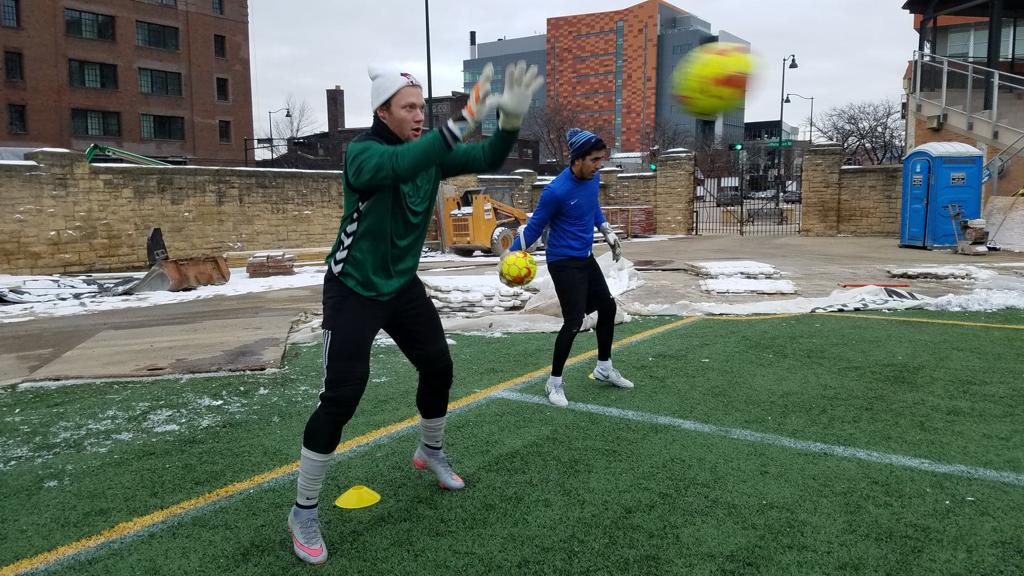
As I came to the realization, long in the making, that I wouldn’t properly be able to explain how exactly being competitive in a pro soccer tryout feels, I began to start looking for someone to talk to. As I asked around, I began hearing about a goalkeeper who had apparently come all the way from Europe to be at the tryout.
Wait, what was his name again?
“Mitchell, I think. He’s over there in the bleachers – the guy in the white hat.”
During a break in the action, I walked up to that guy, the one in the green uniform and the white beanie. Mitchell Wolff, 25, is exactly what you’d expect a goalkeeper to look like: a tall build, lanky arms and sweatpants tucked a little awkwardly into his socks to prevent turf burn while diving. His story, too, seems typical for a goalkeeper. When he was young, Wolff liked to play in the outfield, but after his dad convinced him to try going between the sticks once, he found that the adrenaline rush of stopping a goal was even better than the feeling of scoring one. Since then, he hasn’t looked back.
What’s not quite as ordinary, though, is how Wolff had gotten to Madison. A week-and-a-half before the tryouts, he had still been in Sweden.
“In the winter and in the late end of the year we were playing in 32-degree weather,” Wolff said. “To be honest, I got right off the plane and it pretty much felt the same.”
Wolff, who had graduated several years earlier from the University of St. Thomas, had spent the past seven months playing for IFK Ås and IK Arvika in the Swedish fourth division.
At this point, I had become accustomed to hearing about the long and short distances that players had traveled to get to Breese Stevens Field. I’d met players who’d come from Florida, Saint Paul, Minn., a few guys from universities in Illinois, and of course many who lived here in Wisconsin. One player who was from Columbus, Ohio, told me that he had driven nine hours through wintry weather, passing crashed cars along the highway. This was going to be his fourth tryout.
But Sweden? That’s insane.
As it turns out, for Wolff, it was just another step towards trying to fulfill his ultimate dream – the dream that everyone on that field had, the dream that even I had considered – of becoming a professional soccer player.
“A contact set me up with an agent in Sweden who places players on Scandinavian teams, so I ended up following the call,” Wolff told me. “I’ve been trying go wherever I can [to] play and develop and contribute to a team.”
There we go. Finally, I had my perfect source. Someone who could play at a high level and had come from far, far away just to be here. At last, it was time to learn what it’s really like to try out for a professional soccer team. Could this be the fateful moment, the piece of truth I had been seeking this entire time?
I inched towards the question. When we were almost done talking, I asked it. “How was it tonight?” I said. “How was Madison?”
“It was great, he replied. “I’ve played at this field twice before so I have a soft spot for Breese Stevens.”
Okay, go on, Mitchell. Tell me what I want to hear.
“Now finishing the day here it’s a little bit colder.”
Oh. The cold? Of course he had to mention the cold.
“It’s pretty similar to the conditions I was used to in Sweden,” Wolf continued, “So I was well-prepared in a lot of ways.”
We didn’t really get into too many more details, but honestly, I think I had heard what I needed to. Regardless of how much soccer experience any of the players had, how much talent they brought to the field, how in-shape they were and ready to play, everyone only had one thing at the front their minds: the cold.
It’s almost as if, even after all my searching, the real answer to my question had lain hidden in plain sight the whole time. Perhaps extremely talented soccer players are just regular human beings, but better at sports. Perhaps what it’s “really like” to try out for a professional soccer team isn’t that special at all – it’s just another few games of soccer, same as always, with the weather more remarkable than anything else.
As I came to the realization, long in the making, that I wouldn’t properly be able to explain how exactly being competitive in a pro soccer tryout feels, I began to start looking for someone to talk to. As I asked around, I began hearing about a goalkeeper who had apparently come all the way from Europe to be at the tryout.
Wait, what was his name again?
“Mitchell, I think. He’s over there in the bleachers – the guy in the white hat.”
During a break in the action, I walked up to that guy, the one in the green uniform and the white beanie. Mitchell Wolff, 25, is exactly what you’d expect a goalkeeper to look like: a tall build, lanky arms and sweatpants tucked a little awkwardly into his socks to prevent turf burn while diving. His story, too, seems typical for a goalkeeper. When he was young, Wolff liked to play in the outfield, but after his dad convinced him to try going between the sticks once, he found that the adrenaline rush of stopping a goal was even better than the feeling of scoring one. Since then, he hasn’t looked back.
What’s not quite as ordinary, though, is how Wolff had gotten to Madison. A week-and-a-half before the tryouts, he had still been in Sweden.
“In the winter and in the late end of the year we were playing in 32-degree weather,” Wolff said. “To be honest, I got right off the plane and it pretty much felt the same.”
Wolff, who had graduated several years earlier from the University of St. Thomas, had spent the past seven months playing for IFK Ås and IK Arvika in the Swedish fourth division.
At this point, I had become accustomed to hearing about the long and short distances that players had traveled to get to Breese Stevens Field. I’d met players who’d come from Florida, Saint Paul, Minn., a few guys from universities in Illinois, and of course many who lived here in Wisconsin. One player who was from Columbus, Ohio, told me that he had driven nine hours through wintry weather, passing crashed cars along the highway. This was going to be his fourth tryout.
But Sweden? That’s insane.
As it turns out, for Wolff, it was just another step towards trying to fulfill his ultimate dream – the dream that everyone on that field had, the dream that even I had considered – of becoming a professional soccer player.
“A contact set me up with an agent in Sweden who places players on Scandinavian teams, so I ended up following the call,” Wolff told me. “I’ve been trying go wherever I can [to] play and develop and contribute to a team.”
There we go. Finally, I had my perfect source. Someone who could play at a high level and had come from far, far away just to be here. At last, it was time to learn what it’s really like to try out for a professional soccer team. Could this be the fateful moment, the piece of truth I had been seeking this entire time?
I inched towards the question. When we were almost done talking, I asked it. “How was it tonight?” I said. “How was Madison?”
“It was great, he replied. “I’ve played at this field twice before so I have a soft spot for Breese Stevens.”
Okay, go on, Mitchell. Tell me what I want to hear.
“Now finishing the day here it’s a little bit colder.”
Oh. The cold? Of course he had to mention the cold.
“It’s pretty similar to the conditions I was used to in Sweden,” Wolf continued, “So I was well-prepared in a lot of ways.”
We didn’t really get into too many more details, but honestly, I think I had heard what I needed to. Regardless of how much soccer experience any of the players had, how much talent they brought to the field, how in-shape they were and ready to play, everyone only had one thing at the front their minds: the cold.
It’s almost as if, even after all my searching, the real answer to my question had lain hidden in plain sight the whole time. Perhaps extremely talented soccer players are just regular human beings, but better at sports. Perhaps what it’s “really like” to try out for a professional soccer team isn’t that special at all – it’s just another few games of soccer, same as always, with the weather more remarkable than anything else.
As the day wrapped up, I climbed down from the press box, zipped up my coat and pulled my gloves on tightly. Coach Shore had rounded up the players at the center circle, calling out the jersey numbers of those he wanted to keep around for one final scrimmage.
“98, 74, 78, 118…”
As he continued counting, the players who hadn’t heard their numbers called began to look off in the distance, or down at their shoelaces. Anywhere but at Shore, who at last delivered the final verdict.
“…16, 122, 106, 92, 78,” he finished. “Again, if I didn’t call your number, thank you again – we really appreciate it and we wish you guys the best of luck. Uniforms are yours to keep.”
The players who were still sitting down were left to shuffle off, dejected. I looked for the guys I had warmed up with earlier, but didn’t see them. The sun was finally beginning to set, the already-small patches of fans had thinned out and it was just two sets of soccer players under the lights, one wearing neon-green and the other in white, running about, trying to score goals.
After Shore blew the final whistle, he once again gathered the players up at the center circle. The same routine. This time, only four were left to move on to Saturday’s invitation tryout. I was hoping that I would hear Mitchell’s name called, but it wasn’t. He shook my hand, and along with most of the others, wandered off into the dark – but above all cold – November night.
Later on, I had a chance to chat with Brian Bement, one of the two players the team signed Tuesday that had made it through the invitation tryout. After seeing the skill level of all the players who didn’t even make it to the second round, it came as no surprise to me to hear how high he thought the quality was.
“It was competitive,” Bement told me. “There were some good players out there. Everyone, you could tell, was fighting for that [roster] spot.”
Bement ended up scoring a handful of goals, although Shore would go on to say it was the forward’s work ethic that helped him make the final choice.
“It just kind of worked out,” Bement said. “Hard work was the biggest thing.”
But when I asked him more generally about how it went, though, I knew exactly how he was going to respond.
“It was very cold,” he said. “And dark.”
As the day wrapped up, I climbed down from the press box, zipped up my coat and pulled my gloves on tightly. Coach Shore had rounded up the players at the center circle, calling out the jersey numbers of those he wanted to keep around for one final scrimmage.
“98, 74, 78, 118…”
As he continued counting, the players who hadn’t heard their numbers called began to look off in the distance, or down at their shoelaces. Anywhere but at Shore, who at last delivered the final verdict.
“…16, 122, 106, 92, 78,” he finished. “Again, if I didn’t call your number, thank you again – we really appreciate it and we wish you guys the best of luck. Uniforms are yours to keep.”
The players who were still sitting down were left to shuffle off, dejected. I looked for the guys I had warmed up with earlier, but didn’t see them. The sun was finally beginning to set, the already-small patches of fans had thinned out and it was just two sets of soccer players under the lights, one wearing neon-green and the other in white, running about, trying to score goals.
After Shore blew the final whistle, he once again gathered the players up at the center circle. The same routine. This time, only four were left to move on to Saturday’s invitation tryout. I was hoping that I would hear Mitchell’s name called, but it wasn’t. He shook my hand, and along with most of the others, wandered off into the dark – but above all cold – November night.
Later on, I had a chance to chat with Brian Bement, one of the two players the team signed Tuesday that had made it through the invitation tryout. After seeing the skill level of all the players who didn’t even make it to the second round, it came as no surprise to me to hear how high he thought the quality was.
“It was competitive,” Bement told me. “There were some good players out there. Everyone, you could tell, was fighting for that [roster] spot.”
Bement ended up scoring a handful of goals, although Shore would go on to say it was the forward’s work ethic that helped him make the final choice.
“It just kind of worked out,” Bement said. “Hard work was the biggest thing.”
But when I asked him more generally about how it went, though, I knew exactly how he was going to respond.
“It was very cold,” he said. “And dark.”
